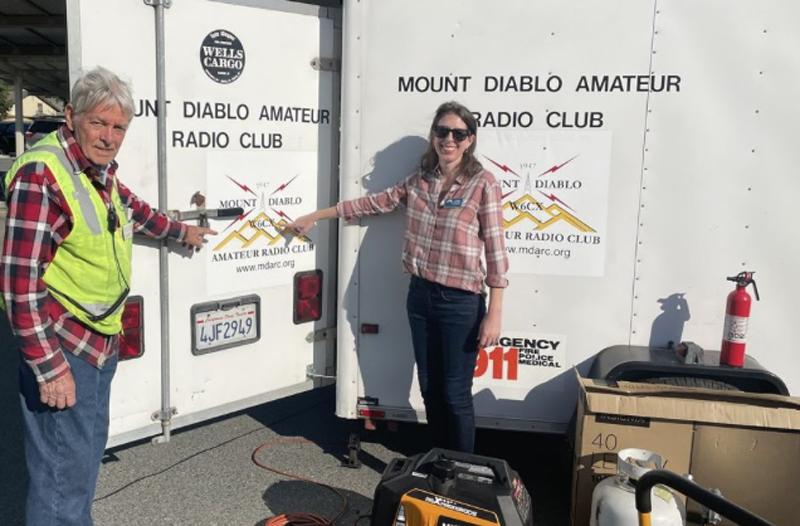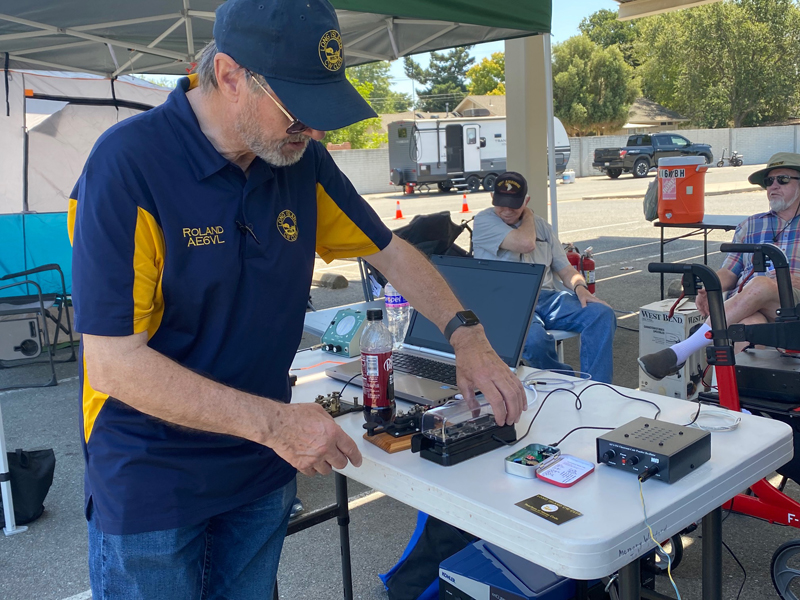Field Day showcases the power of Ham radio’s reach

CONCORD, CA (July 26, 2024) — Amateur radio, aka Ham radio, is as personal as it is communal, and both were on display as part of the annual Field Day hosted by the Mt. Diablo Amateur Radio Club (MDARC) June 22 and 23 at Olympic High School.
The setup resembled a tailgate party or weekend campout in Yosemite. Diehards and their spouses came with their RVs and trailers, camping tables and chairs, additional tents to provide cover and, of course, food and drink to combat sunny conditions approaching 100 degrees that would test even the heartiest amateur radio enthusiasts as they set up gear in the parking lot along Salvio Street.
MDARC president Larry Bradley described Ham radio as appealing to a diverse group of people from many different backgrounds and experiences.
“We have the tinkerers, those that like to serve in public service and those that participate in contests that expand the globe in making radio contacts with fellow Hams,” he said.
Radio key to family history
Martinez resident Pete Harris, 78, recalls being fascinated by how voices managed to come through a wooden radio box in the days before TV. But beyond those boyhood memories of listening to Howdy Doody, the Lone Ranger and Big John and Sparky, his appreciation for the power of radio was cultivated in how it impacted the lives of his Jewish parents during World War II.
“My parents escaped from Croatia (Yugoslavia) suddenly one night as the Nazis took over the country,” he said. “They escaped into Northern Italy on a German-controlled train with false Catholic baptism records provided by my dad’s good friend.”
Short-wave radio was the one resource – albeit illegal – that citizens used to track Nazi movements and learn where the front lines were. After finally reaching Southern Italy during a three-year odyssey from 1941-1944, his parents were able to come to America after the war ended and start a new life.
Today, Harris shares his love of Ham radio with his four grandkids, ages 9 to 19, when he visits them in San Antonio. He sets up his portal antenna that allows them to communicate with folks thousands of miles away, including those living in Brazil.
Honing their skills
Harris convened with dozens of other MDARC members for the Concord event that showcases how attendees keep up skills in case of an emergency, compete for points with other organizations around North America to see which can achieve the most contacts over the two days, and lastly, have fun with their fellow amateur radio operators.
Mike Warren of Pittsburg, who has been licensed since 1978, noted an interest in his youth with electronics and science and taking things apart to know “how things work” as leading to involvement in amateur radio.
Ham radio is the most powerful communications service available to private citizens anywhere on – and above – Earth. Licensed operators can use the radio airwaves at no cost, other than the price of their equipment and license.
As part of the event, individuals who had taken classes through the local club could test for their licenses. The Federal Communications Commission (FCC) grants a license after the operator passes a test demonstrating knowledge of Ham radio operating rules and procedures, electronics, signal propagation (atmospheric effects on radio signals), safety and equipment.
“It’s a license to learn,” said Bradley, citing the virtue of “keeping us old guys active and stimulated.”
Three levels of achievement
There are three license levels. The first level, Technician, gives the operator many permissions on the airwaves. The next two levels, General and Amateur Extra, expand on those permissions and knowledge of electronics, antennas, safety and propagation.
Half of all licensed Hams in the United States find that the Technician level is so much fun and meets their communication needs that they stay at that level.
Field Day saw four new Technicians, including one youth, one new General and two new Amateur Extra Hams, according to event chair Larry Loomer.
The Mt. Diablo club holds classes and testing throughout the year, and there is no age requirement for obtaining a license. The interest in Ham radio has extended to Scouting, offering merit badges for studying for a license or learning some of the skills needed to operate as a Ham, along with programs in area schools.
MDARC has many other activities during the year, including hosting a three-day Western Regional convention in San Ramon in October. Members also lend their time and skills as volunteers providing safety and communication services at public service events such as running and biking races, reports treasurer Barb Whysong.
“Being active with the club has helped me expand my social network after retirement, and I’ve become interested in some of the scientific aspects of Ham radio, particularly propagation of signals and solar activity,” she said. “I don’t have a math or electronics background, but I still enjoy the hobby.”
Incorporating Morse Code

Along with exposing the public to the latest Ham technology, Field Day also reminded the community of its origins through Morse Code, or Continuous Wave (CW), with finger- and foot-operated devices on hand to try.
Until 2007, understanding of Morse Code was integral to the first stage of licensure. While seemingly archaic in today’s high-tech world, “people-intensive” Morse Code has enjoyed a resurgence, according to Roland Williams of Martinez. The longtime proponent is affiliated with Long Island CW Club that teaches Morse Code.
It was one of the three modes MDARC members used during the weekend event as they competed against other clubs across the country, said Dick Wade, the club’s outreach coordinator.
Each successfully matched contact using CW/Morse Code earned two points. Those achieved using digital or FT8, in which a computer does the decoding, garnered two points. Voice, or signal sideband, gave a Ham operator one point per contact.
MDARC member Trevor Raty, who helped develop and run the contest/radio operations side, said they achieved 493 total contacts – broken down as 182 with CW/Morse Code, 62 digital/FT8 and 249 voice.
Raty didn’t expect a high placement nationally, as “band conditions were pretty poor, and we ran into some technical issues.”
Productive experience
Despite the challenges, Raty still regarded the two-day outing as a positive and productive experience.
“Field Day isn’t just about the contest; it’s about getting out and trying to operate in conditions you’re not used to, and to demonstrate what is possible,” said Raty, a license holder since 2002 and currently an Extra class. “I personally learned some new troubleshooting tips and Morse Code setups.
“Everyone learns something from these events,” he added, “from operators on how to work the radio in unfamiliar conditions, new Hams wanting to work HF (high frequency) and the public leaning what we do.”
Loomer hopes the public saw that Ham radio isn’t just about talking to other people around the world.
“We need to emphasize that we train for providing emergency communication wherever it is needed by the community,” said Loomer. “There is a saying: When all else fails, Ham radio is there.”

David Scholz
David Scholz is back in journalism as a freelance writer and photographer after nearly two decades in education. Prior to moving into teaching in 2000, he worked as a full-time journalist since 1988 for rural community and small daily newspapers in Central Ohio and Northern Nevada, and later in California with The Business Journal in Fresno and dailies in the Bay Area, including The Oakland Tribune and The San Francisco Chronicle. More recently Scholz also worked in an editing, writing, and page layout role with the Rossmoor News.
